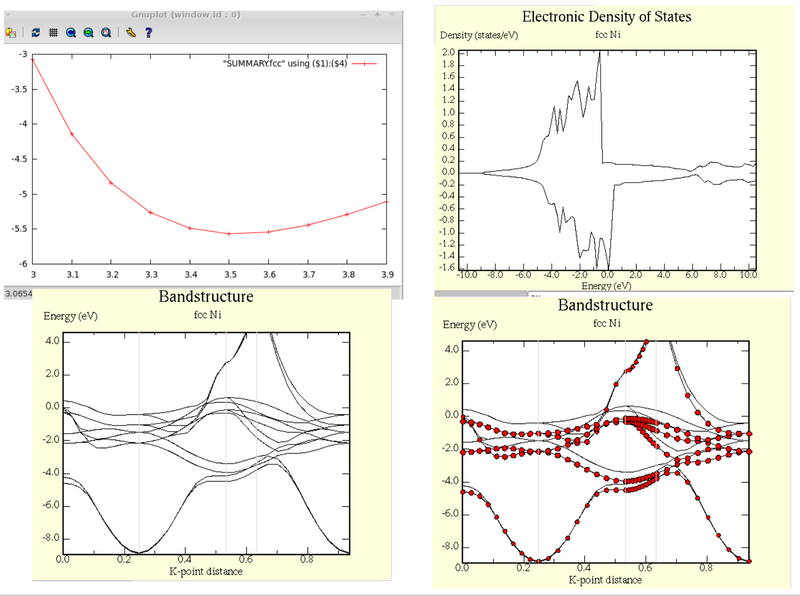Fcc Ni: Difference between revisions
No edit summary |
|||
| (14 intermediate revisions by the same user not shown) | |||
| Line 1: | Line 1: | ||
{{Template:Bulk_systems - Tutorial}} | |||
== Task == | |||
Lattice parameter optimization, calculation of the DOS and bandstructure in (spin-polarized) fcc Ni. | |||
== Input == | |||
=== {{TAG|POSCAR}} === | |||
fcc: | fcc: | ||
3.53 | 3.53 | ||
| Line 30: | Line 17: | ||
0 0 0 | 0 0 0 | ||
=== {{TAG|INCAR}} === | |||
{{TAGBL|SYSTEM}} = fcc Ni | |||
{{TAGBL|ISTART}} = 0 ; {{TAGBL|ICHARG}}=2 | |||
{{TAGBL|ENCUT}} = 270 | |||
{{TAGBL|ISMEAR}} = 1 ; {{TAGBL|SIGMA}} = 0.2 | |||
{{TAGBL|LORBIT}} = 11 | |||
{{TAGBL|ISPIN}} = 2 | |||
{{TAGBL|MAGMOM}} = 1 | |||
0. | *Initial charge-density from overlapping atoms in starting job. | ||
*Default energy cutoff of 270 eV used ({{TAG|ENCUT}}=270). | |||
*MP smearing used since we have a metal. | |||
1 | *Spin-polarized calculation {{TAG|ISPIN}}=2, initial moments of 1 ({{TAG|MAGMOM}}=1). | ||
*Static calculation. | |||
=== {{TAG|KPOINTS}} === | |||
k-points | |||
0 | |||
Monkhorst Pack | |||
11 11 11 | |||
0 0 0 | |||
*Equally spaced k mesh with 56 points in the IBZ. | |||
*Odd, <math>\Gamma</math>-centered mesh. | |||
== Calculation == | |||
*The calculations are carried out in analogy to {{TAG|cd Si}}. Please follow the instructions in that example. | |||
*Here is a sample output of the results: | |||
[[File:Fig Ni 1.png|800px]] | |||
== Download == | == Download == | ||
[ | [[Media:FccNi.tgz| fccNi.tgz]] | ||
{{Template:Bulk_systems}} | |||
[[Category:Examples]] | [[Category:Examples]] | ||
Latest revision as of 13:22, 14 November 2019
Overview > fcc Si > fcc Si DOS > fcc Si bandstructure > cd Si > cd Si volume relaxation > cd Si relaxation > beta-tin Si > fcc Ni > graphite TS binding energy > graphite MBD binding energy > graphite interlayer distance > List of tutorials
Task
Lattice parameter optimization, calculation of the DOS and bandstructure in (spin-polarized) fcc Ni.
Input
POSCAR
fcc: 3.53 0.5 0.5 0.0 0.0 0.5 0.5 0.5 0.0 0.5 1 cartesian 0 0 0
INCAR
SYSTEM = fcc Ni ISTART = 0 ; ICHARG=2 ENCUT = 270 ISMEAR = 1 ; SIGMA = 0.2 LORBIT = 11 ISPIN = 2 MAGMOM = 1
- Initial charge-density from overlapping atoms in starting job.
- Default energy cutoff of 270 eV used (ENCUT=270).
- MP smearing used since we have a metal.
- Spin-polarized calculation ISPIN=2, initial moments of 1 (MAGMOM=1).
- Static calculation.
KPOINTS
k-points 0 Monkhorst Pack 11 11 11 0 0 0
- Equally spaced k mesh with 56 points in the IBZ.
- Odd, -centered mesh.
Calculation
- The calculations are carried out in analogy to cd Si. Please follow the instructions in that example.
- Here is a sample output of the results:


